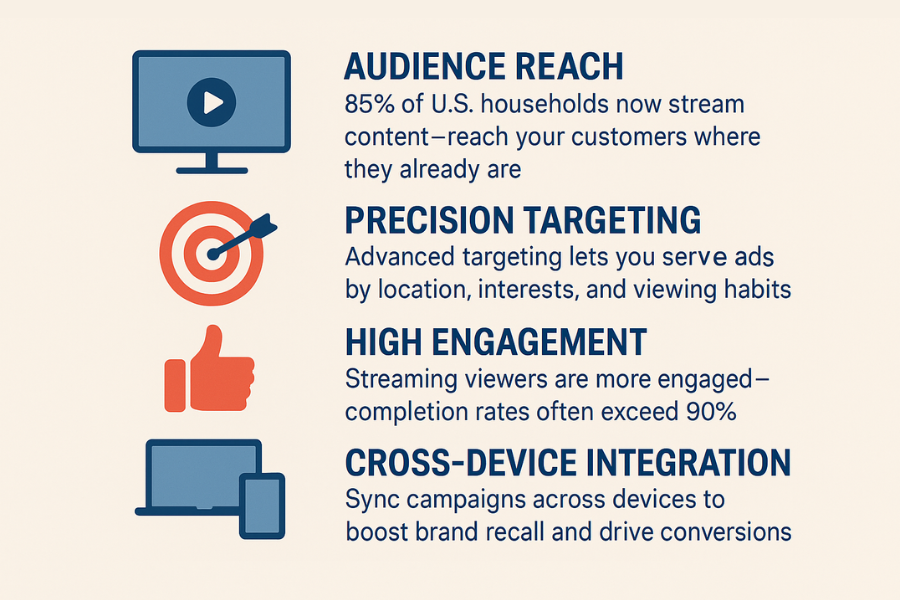Streaming TV advertising has rapidly become a cornerstone of modern digital marketing strategies. As viewers migrate away from traditional cable and satellite TV, brands must follow audiences to the platforms where they now spend the majority of their time—on-demand streaming services. This shift has given rise to over-the-top (OTT) and connected TV (CTV) advertising, offering businesses of all sizes a highly targeted, measurable, and cost-effective way to reach their ideal customers.
This in-depth guide explains what streaming TV advertising is, how it works, the advantages it offers in 2025, and why your business should strongly consider making it part of your digital marketing strategy.
What Is Streaming TV Advertising?
Streaming TV advertising refers to video ads served via internet-connected platforms—replacing the traditional cable or broadcast TV model. These ads appear within or around streaming video content on platforms such as Hulu, Roku, Amazon Fire TV, YouTube TV, Pluto TV, and Tubi.
Unlike traditional TV ads that are bought based on time slots and general demographics, streaming TV advertising enables brands to target users based on detailed data including:
-
Geographic location (zip code, city, or region)
-
Age and gender
-
Income level
-
Household composition
-
Online behavior and interests
-
Device usage patterns
This data-driven model ensures businesses can deliver their message to a more precise audience, increasing engagement while minimizing waste.
Here’s a quick overview of the core benefits of streaming TV advertising:

OTT vs. CTV: Understanding the Ecosystem
To effectively navigate streaming TV advertising, it’s important to understand the difference between OTT and CTV:
-
OTT (Over-the-Top): Refers to the delivery of video content directly over the internet, bypassing traditional cable. Examples of OTT platforms include Hulu, Sling TV, and Peacock.
-
CTV (Connected TV): Refers to any internet-connected device that delivers OTT content, such as smart TVs, Roku sticks, Apple TV, or gaming consoles.
While OTT focuses on how the content is delivered, CTV defines the devices where that content is viewed. Advertisers often use these terms interchangeably, but they represent different layers of the ad delivery infrastructure.
Why Streaming TV Advertising Matters in 2025
1. Growing Cord-Cutting Audiences
The number of cord-cutters—households that have abandoned cable TV in favor of streaming—is growing rapidly. In 2025, it’s estimated that over 90 million U.S. households will consume video content exclusively through streaming platforms. Brands that fail to adapt risk losing access to a massive and engaged audience.
2. Enhanced Targeting and Personalization
Traditional TV offers broad reach but limited targeting. Streaming TV advertising uses first-party and third-party data to serve personalized ads to specific viewers. You can:
-
Deliver different creatives based on user location or preferences.
-
Target only those likely to be interested in your product or service.
-
Retarget users who previously visited your website or app.
3. Better Engagement and Completion Rates
Most streaming platforms serve non-skippable ads that are placed within premium content. Viewers are more likely to watch these ads in full compared to banner or social ads, leading to stronger brand recall and message retention.
4. Measurable Performance Metrics
Unlike traditional television, where success is difficult to quantify, streaming TV provides clear data on:
-
Impressions
-
Video completion rates
-
Frequency
-
Conversions (including website visits, form fills, and purchases)
-
Attribution across devices
These metrics enable marketers to optimize campaigns in real time and measure actual return on investment (ROI).
5. Cost-Effective for Businesses of All Sizes
OTT and CTV ads are accessible to both local and national brands. You can start with a modest budget and scale based on performance. Many platforms allow for flexible minimum spend requirements and support geo-targeted campaigns.
6. High-Quality Brand Environment
Ads run alongside professionally produced content, giving your brand visibility in a premium, brand-safe environment. This is especially important for industries where trust and credibility are critical, such as healthcare, finance, or education.
Real-World Example: Local Business Use Case
A regional auto dealership wants to promote its spring sale. Instead of running a costly local TV spot, it uses OTT advertising to reach potential buyers within a 15-mile radius who recently searched for car reviews or visited a competitor’s website. The campaign results in:
-
85% video completion rate
-
30% lift in website traffic during the campaign
-
Measurable leads through a custom landing page
This type of targeted, performance-based approach is what makes streaming TV so valuable for local and mid-sized businesses.
How to Launch a Streaming TV Ad Campaign
If you’re considering launching a streaming TV campaign, here are the essential steps:
1. Define Your Audience: Know exactly who you want to reach based on demographic and behavioral data.
2. Set Clear Objectives: Whether it’s brand awareness, website visits, or conversions, your goal should guide creative and platform selection.
3. Choose the Right Platforms: Depending on your audience, choose platforms like Hulu for younger demographics, Roku for reach, or niche networks for specialized targeting.
4. Create Compelling Video Ads: Develop professional, story-driven ads that reflect your brand voice and include a clear call to action.
5. Monitor and Optimize: Use real-time analytics to adjust targeting, creatives, or frequency based on performance.
Common Myths About Streaming TV Advertising
Myth 1: It’s only for big brands.
Reality: Many platforms cater to small businesses with flexible budgets and self-serve ad tools.
Myth 2: It’s just like running a YouTube ad.
Reality: Streaming TV ads appear in premium, full-screen environments and are often non-skippable, leading to higher engagement.
Myth 3: It’s hard to track ROI.
Reality: Advanced analytics platforms now provide detailed reporting and attribution models.
Frequently Asked Questions (FAQs)
1. Can I run local campaigns on streaming platforms?
Absolutely. One of the most powerful advantages of streaming TV advertising is its hyper-local targeting capability. You can run campaigns that are limited to specific zip codes, cities, or even neighborhoods. This is especially effective for businesses like restaurants, dealerships, clinics, and service providers that rely on drawing customers from a defined area. Platforms like Hulu, Roku, and Tubi allow advertisers to customize who sees the ads based on geography, demographics, and interests, ensuring that your message is shown only to the most relevant viewers. This level of precision isn’t possible with traditional TV advertising.
2. Do streaming ads perform better than traditional TV?
Yes, in most measurable ways. Streaming ads are typically delivered in non-skippable, premium environments, which means your message is more likely to be viewed in full. You also get access to detailed performance metrics—like video completion rates, impressions, and viewer engagement—which helps optimize your campaigns over time. In contrast, traditional TV relies on estimated ratings and lacks the data transparency of OTT platforms. Streaming TV also enables cross-device attribution, so you can track a viewer from seeing your ad on their smart TV to taking action on their phone or laptop, giving you a clearer picture of ROI.
3. What industries benefit most from streaming TV advertising?
A wide range of industries see strong results with streaming TV ads, especially those that benefit from local visibility, brand trust, and visual storytelling. These include:
-
Automotive – Promote sales, events, or new inventory to potential buyers within driving distance.
-
Healthcare – Build awareness for urgent care centers, dental clinics, or wellness services in a local area.
-
Education – Private schools, universities, and training centers can target households with school-age children.
-
Retail – Brick-and-mortar stores can drive foot traffic, while eCommerce brands use OTT for broader awareness.
-
Legal services – Law firms can target specific geographic areas and demographics for campaigns.
-
Tourism and hospitality – Perfect for showcasing destinations, hotels, or events with immersive visuals.
Each of these industries benefits from the ability to control where, when, and to whom the ads are shown, which makes streaming TV a flexible and powerful addition to their marketing mix.
Final Thoughts
Streaming TV advertising is not just the future—it’s the present. With precision targeting, detailed analytics, and lower barriers to entry, it offers businesses an unmatched opportunity to reach audiences where they’re most active. In a landscape where attention is fragmented across devices and platforms, OTT and CTV advertising provides the reach of television with the accountability of digital marketing.
Ready to Launch Your Streaming TV Campaign?
At Space Creative Agency, we help businesses in Madison and beyond harness the full power of streaming TV advertising. Whether you’re targeting a local audience or building a national brand, our team can guide you from creative production to performance analytics.
Contact us today at 608-217-8434 to schedule a free consultation.

